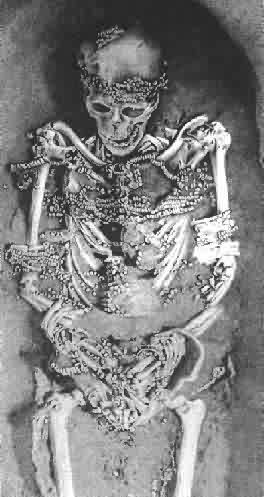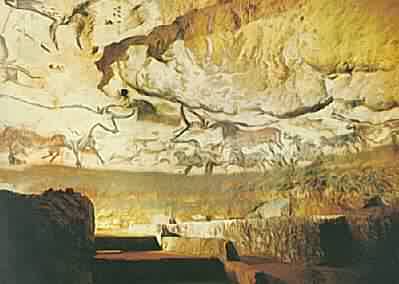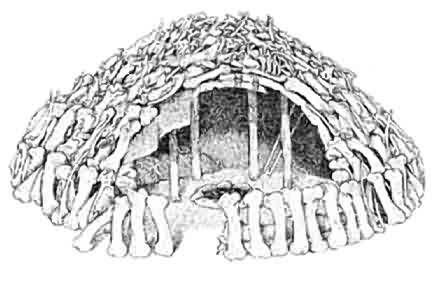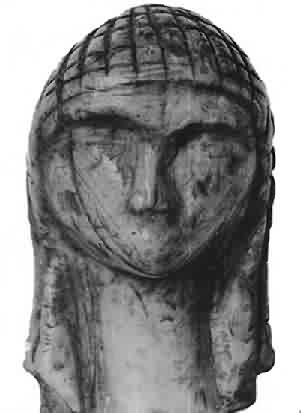
MARCH OF THE TITANS - A HISTORY OF THE WHITE RACE
CHAPTER 2 : THE LATE PALEOLITHIC AGE
The first racial types identifiable as similar to modern Whites first appeared in parts of Europe, southern Russia and the Near East during the time period 30,000 BC to 15,000 BC, following the end of the last great Ice Age around the year 40,000 BC.
The new arrivals are known as Homo Sapiens (or "wise man") in order to differentiate them from the other life forms known as Homo Erectus and Neanderthal man.
These first racial types occurred in two main physical forms: the original Mediterraneans ("Old Europeans") who had dark or brown hair and dark eyes; and then what is called the Proto Nordic or Cro-Magnon racial type - tall, light hair and light eyes. In certain isolated areas in Europe - centered in Scandinavia - it is possible even today to find perfect living examples of this Proto Nordic racial type, differing only slightly in height from modern day Nordics.
This Proto-Nordic race's physical remains are however plentiful as they wandered far and wide. They lived in a broad band spanning from Spain right across Europe all the way to Asia, where skeletal remains have been found.

One of the most remarkable finds from the Upper Paleolithic era is this clothed adult White male, discovered in Sungir, Russia, buried some 25,000 years ago. This was the type of person who created the first known inklings of White civilization of the present interglacial period starting approximately 40,000 BC. The intricacy of the bead work and material with which the corpse was buried is evidence that White Upper Paleolithic man was at this stage already fairly advanced - compared to Africa where woven material was introduced as recently as only 500 years ago.
NORDIC TYPES COMPROMISE RULING ELITE
The Mediterranean and Proto-Nordic types also quite often inhabited the same geographic areas - particularly so in the Middle and Near East, but also extending to western Europe and the Balkans.
A certain amount of mixing took place, but as the Mediterranean types were in the overwhelming majority, the incidence of Nordic characteristics amongst these first Whites was relatively low, with most Nordic types comprising the ruling elite of these peoples.
NEANDERTHALS EXTINGUISHED
This time period, circa 25,000 BC, is known as the Late Paleolithic era and was marked by two main characteristics - the hunter-gatherer stage of early White existence; and the extinction of Neanderthal man (through conflict with the new arrivals).
HUNTER GATHERERS
The Proto-Nordics of the Late Paleolithic age wandered from area to area, never settling for long and often being driven on by the elements and sometimes following new lands opened up by the then retreating last ice sheets.
As a result of the transient nature of these people, they generally traveled in family groups, usually varying between five and twenty individuals. Small numbers of livestock and hunting provided their main means of sustenance.
While no great buildings or fixed structures remain from this period, smaller day-to-day artifacts are relatively plentiful. Excavations across Europe and Russia have shown that these early Whites had fire, paint, stone blades and the ability to fashion animal bones into weapons and tools. Sewing needles were also developed during this period.
27,000 BC - MUSICAL INSTRUMENTS AND CERAMICS
Musical instruments also made their appearance- at sites in southern France, flutes dating back 27,000 years have been found. Coal was also first used as a fuel at about this time. The southern parts of Europe would have been the primary point of contact between the Northern Proto-Nordics and the Mediterranean types.
These early Whites also developed fired ceramics, with statuettes and other fired objects dating from approximately 26,000 BC having been found in the present day Czech Republic.
Two significant weapons were also developed at this time which marked a great improvement on the till then basic spear: the spear thrower (which was an instrument made of bone which gave the thrower greater leverage and thus greater speed and distance) which made its appearance around 12,000 BC; and the bow and arrow which first made its appearance around 9000 BC.

Spear thrower carved with a leaping horse, Montastruc, France, circa 12,000 BC Late Paleolithic period.

Cave paintings at Lascaux, France, circa 20,000 BC. Late Paleolithic period.
It was this period which produced, across Europe, a number of voluptuous female figure forms which have become known as "primitive venuses". It is speculated that these figurines are fertility symbols.

The earliest art: the Woman from Willendorf, present day Austria, dating from 30,000 BC. Late Paleolithic period.
AZILIAN ART - FIRST WRITING?
Perhaps the greatest difficulty of studying people of the Late Paleolithic age was that they left no written records of their achievements - only paintings on rock walls. One of the best preserved examples is also the most intriguing - the rock paintings found in caves of Mes d'Azil in southern France. Here stones were found with what appears to be writing on them - although they have never been deciphered, if they are indeed writing, then they might be the first and oldest form of written communication in the world.

The Azilian "alphabet" stones, some 9000 years old. Discovered in the south of France, archaeologists are still debating if they are in fact writing or not. They do bear an uncanny resemblance to scripts which were developed several thousands of years later. If it is writing, then it is the oldest on earth.
EARLIEST HOUSES
The earliest remains of buildings date from the time of the hunters of the Late Paleolithic period who inhabited the areas now known as the Czech and Slovak republics and southern Russia. To withstand the cold weather, Late Paleolithic hunter groups made clothes from sewn skins - traces of which have survived in sites in the Czech and Slovak republics.
Mammoths - elephantine creatures now extinct - were hunted during this time period and houses were constructed out of mammoth ribs (which were used a roof supports). There are also traces of Late Paleolithic people having used the limestone caves of Western Europe as shelters.

The first houses were constructed out of Mammoth bones and hide: this reconstruction is based on evidence found in southern Russia, dated between 30,000 and 20,000 BC.
All in all, Late Paleolithic life must have been bare, hard and cruel, with all the energies of the members of society being put almost solely into survival.
The transient nature of society at this time was the primary cause of the lack of any great fixed settlements - this would be a development that would come with the establishment of agriculture, a feature of the time period after 10,000 BC.
ALPINES EMERGE
Around this time, the Alpine sub grouping appeared: possibly as a result of mixing between the Proto-Nordic and Mediterranean types (this is however speculation).
These three groupings - Proto-Nordics, original Mediterraneans and Alpines - settled large parts of Europe and the Near and Middle East, a situation which remained stable until the entire continent was subjected to invasions by White Nordic tribes - called the Indo-European peoples, which started around 5000 BC.
The Nordic Indo-European peoples and the Alpines today form the basis of the White race which inhabits Europe.

A small ivory head of a female figure with delicately carved features and stylized long hair, found at Brassempouy in France - circa 22,000 BC. This piece is exceptionally valuable as racial characteristics are clearly identifiable in the face.
The three White sub groupings - Nordic, Alpine and original Old European Mediterranean, were eventually together to dominate a band of territory stretching from Britain to the Ural Mountains; from Scandinavia to North Africa and the Near East; stretching through Egypt, Palestine, modern day Jordan, Syria, Iraq and Iran.
With the advent of time, the Middle and Near East was to become a maelstrom of races, with waves of settling Whites, Arabics, Semites and even Mongols all at one time or another dominating the region and establishing their own cultures and civilizations.
The present day inhabitants of the Near and Middle East are the product of many thousands of years of mixing between all these groupings, and traces of each of the original groupings can sometimes be seen - blond haired Palestinians or blue eyed Iraqis are not unknown - the genetic evidence of the presence of White tribes which occupied that region in ancient times.
or back to
or
All material (c) copyright Ostara Publications, 1999.
Re-use for commercial purposes strictly forbidden.